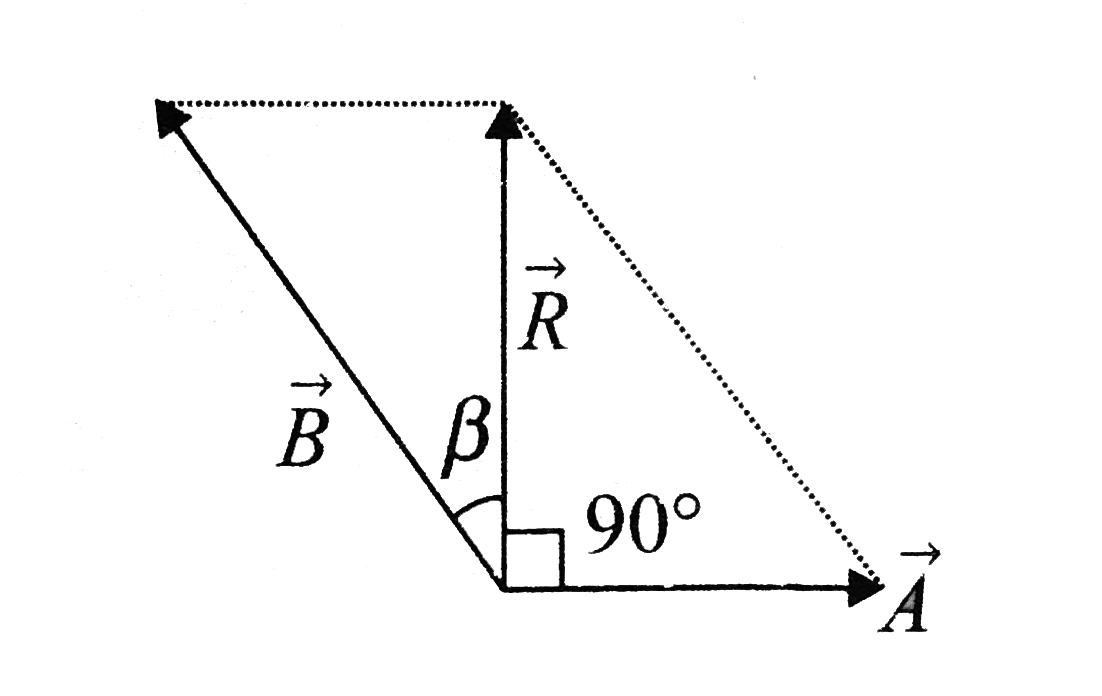→A and →B are two vectors having equal magnitude. If magnitude of →A+→B is two times magnitude of →A−→B than angle between A and B is?
To solve the problem, we need to find the angle between two vectors →A and →B given that they have equal magnitudes and the condition involving their sums and differences. Let's denote the magnitude of both vectors as A (i.e., |→A|=|→B|=A).
1. Given Information:
- |→A|=|→B|=A
- |→A+→B|=2|→A−→B|
2. Express the Magnitudes:
- The magnitude of the sum of two vectors can be expressed as:
|→A+→B|=√|→A|2+|→B|2+2|→A||→B|cosθ
- Since |→A|=|→B|=A, this becomes:
|→A+→B|=√A2+A2+2A2cosθ=√2A2(1+cosθ)=A√2(1+cosθ)
3. Magnitude of the Difference:
- The magnitude of the difference of two vectors can be expressed as:
|→A−→B|=√|→A|2+|→B|2−2|→A||→B|cosθ
- This becomes:
|→A−→B|=√A2+A2−2A2cosθ=√2A2(1−cosθ)=A√2(1−cosθ)
4. Setting Up the Equation:
- According to the problem:
A√2(1+cosθ)=2⋅A√2(1−cosθ)
- Dividing both sides by A (since A≠0):
√2(1+cosθ)=2√2(1−cosθ)
5. Squaring Both Sides:
- Squaring both sides gives:
2(1+cosθ)=4⋅2(1−cosθ)
- Simplifying this leads to:
2(1+cosθ)=8(1−cosθ)
6. Rearranging the Equation:
- Expanding and rearranging:
2+2cosθ=8−8cosθ
2cosθ+8cosθ=8−2
10cosθ=6
- Thus:
cosθ=610=35
7. Finding the Angle:
- Finally, we find the angle θ:
θ=cos−1(35)
Final Answer:
The angle between vectors →A and →B is:
θ=cos−1(35)
- |→A|=|→B|=A
- |→A+→B|=2|→A−→B|
- The magnitude of the sum of two vectors can be expressed as:
|→A+→B|=√|→A|2+|→B|2+2|→A||→B|cosθ
- Since |→A|=|→B|=A, this becomes:
|→A+→B|=√A2+A2+2A2cosθ=√2A2(1+cosθ)=A√2(1+cosθ)
- The magnitude of the difference of two vectors can be expressed as:
|→A−→B|=√|→A|2+|→B|2−2|→A||→B|cosθ
- This becomes:
|→A−→B|=√A2+A2−2A2cosθ=√2A2(1−cosθ)=A√2(1−cosθ)
- According to the problem:
A√2(1+cosθ)=2⋅A√2(1−cosθ)
- Dividing both sides by A (since A≠0):
√2(1+cosθ)=2√2(1−cosθ)
- Squaring both sides gives:
2(1+cosθ)=4⋅2(1−cosθ)
- Simplifying this leads to:
2(1+cosθ)=8(1−cosθ)
- Expanding and rearranging:
2+2cosθ=8−8cosθ
2cosθ+8cosθ=8−2
10cosθ=6
- Thus:
cosθ=610=35
- Finally, we find the angle θ:
θ=cos−1(35)
The angle between vectors →A and →B is:
θ=cos−1(35)
Topper's Solved these Questions
Similar Questions
Two vectors →Aand→B have equal magnitudes.If magnitude of (→A+→B) is equal to n times of the magnitude of (→A−→B) then the angle between →Aand→B is :-
View SolutionTwo vectors vec A and vec B have equal magnitudes.The magnitude of (vec A+vec B) is 'n' times the magnitude of (vec A-vec B).The angle between vec A and vec B is:
View Solution
Knowledge Check
Two vector →Vand→V have equal magnitudes. If magnitude of →A+→B is equal to n time the magnitude of →A−→B, then angel to between →Aand→B is
Acos−1(n−1n+1)Bcos−1(n2−1n2+1)Csin−1(n−1n+1)Dsin−1(n2−1n2+1)Two vectors →A and →B have equal magnitudes. If magnitude of →A−→B is equal to (n) times the magnitude of →A−→B, then angle between →A and →B is ?
Acos−1(n−1n−1)Bcos−1(n2−1n2+1)Ccos−1(n−1n−1)Dcos−1(n2−1n2+1)If →aand→b are two vectors then the value of (→a+→b)×(→a−→b) is
A2(→b×→a)B−2(→b×→a)C(→b×→a)D→a×→b
Two vectors →A and →B have precisely equal magnitudes. For the magnitude of →A+→B to be larger than the magnitude of →A−→B by a factor of n, what must be the angle between them?
View SolutionIsthe magnitude of (→A+→B) same asthat of (→B+→A) ?
View SolutionThe resultant of two velocity vectors →A and →B is perpendicular to →A. Magnitude of Resultant →R is equal to half magnitude of →B. If the angle between →A and →B is (30θ)∘, then value of θ is ?
View SolutionThe resultant of two vectors →A and →B is perpendicular to the vector →A and its magnitudes is equal to half of the magnitudes of vector →B (figure). The angle between →A and →B is

View SolutionTwo vector →A and →B have equal magnitudes. Then the vector →A+→B is perpendicular :
View Solution
